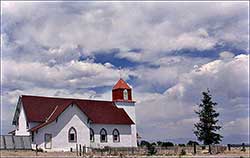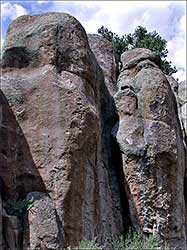 (click on image above for enlargement)
(click on image above for enlargement)
History is a silent companion in La Garita, five miles west of U.S. 285 between Saguache and Center. From the patient spire of the renovated church to the log-cabin general store to the distant canyons, no casual glance could deny the past.
The Ute tribe made their summer camp here, the Spanish settled and raised sheep and the Anglos started farms, each leaving their mark. The canyons of the area display pictographs, a Penitente Madonna and the chalk marks of skilled rock climbers.
The name La Garita means “The Lookout" in Spanish. This reference alone marks the first of two phases of the town’s life. Originally the Ute Indians would use the peaks of the nearby hills to look across the plains and to send smoke signals. Early settlers often reported watching the smoke messages rising from the hills. The Utes would pass through this country as they traveled to the Uncompahgre Valley.
The Spanish first arrived in La Garita in 1858. These hardy people not only named the town, they also brought 3,000 head of sheep and other livestock with them. By the early 1870s La Garita had two schools, one a Catholic, a post office, trading post and sawmill.
The region had the second largest Indian encampment in the Valley, until the Utes signed a treaty in 1868, giving up their rights to the land in the area forever.
Just 1000 feet west of the present town of La Garita was Gueytown, pronounced ”Gaytown,” which had 600 residents. This area along the Wilson Arroyo was the true center of town with the stage stop for the route from Del Norte to Saguache and the livery stables.
Julian Espinoza and the Atencio family donated land to build a Catholic church in the 1870s. The church steeple, said local store owner Ed Lambert, has the only five-pointed cross in the United States. The church was named San Juan de Baptista in honor of the saint whose feast day, June 21, was widely celebrated. The local people would attend mass and then race horses, dance, and in later years, play baseball. The church burned in 1923 and was rebuilt. It closed as a church in 1968, but has now been renovated into an art center.
In 1881, Mark Biedell, who had owned land in the area since 1865, opened a mining camp north of La Garita named Crystal. Frank White writes in his 1971 book, La Garita, that a shepherd brought Mr. Biedell two heavy black rocks and told the investor where he found them. Mr. Biedell gave the shepherd $200, a wagon and a horse to leave the Valley. The mines were active until 1928 and the Esperanza mine was reworked in the 1980s. |
One of the worst years in La Garita history was 1918. A viscous strain of the flu attacked the residents and nearly half the town died. The bodies were buried in a mass grave. Several societies of Los Hermanos Penitentes, the fabled Penitente brotherhood, were established during this time. A building where they met still stands along County Road J. The Penitente Canyon climbing area was named for this group and for a faded blue Madonna painted on a wall in the park.
Despite the strong Spanish presence in the early history of the area, many were run out of the region when they lost their water rights. Some Hispanics never knew that they needed to file for water rights at the county courthouse and the rights were granted to Anglos.
Anglos were an important part of La Garita’s development. Modern La Garita is very different from the days of Gueytown.
The school closed in 1955 and the church stopped holding services in 1968. Only a few homes remain and there is only one business, the La Garita Cash store.
The building for the store was originally a hotel at Mr. Biedell’s mining camp. In 1907, Arthur M. Coolbroth bought the logs, numbered them and used them to build a barn at the mouth of Canero Creek. The building was moved to its present spot in 1923 as a general store and post office. The store traded goods for lumber from the local mills. Originally a two story building, the top floor was removed and a house was added to the side.
 Now Ed and Elle Lambert own the La Garita Cash Store. They sell gas, food and “the best hamburgers in town,” but most importantly, the local ranchers can meet here to get the area’s news and discuss business. Since the opening of Penitente Canyon as a major climbing area, the store has also served tourists and avid rock climbers from as far away as Europe. In fact the climbers have brought a new life to the area. The store had one of its busiest days ever last June. Now Ed and Elle Lambert own the La Garita Cash Store. They sell gas, food and “the best hamburgers in town,” but most importantly, the local ranchers can meet here to get the area’s news and discuss business. Since the opening of Penitente Canyon as a major climbing area, the store has also served tourists and avid rock climbers from as far away as Europe. In fact the climbers have brought a new life to the area. The store had one of its busiest days ever last June.
Though things are peaceful now, the beauty of La Garita, which brought the Ute here and helped name the town may revive the area with a constant stream of tourists. |